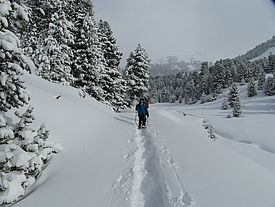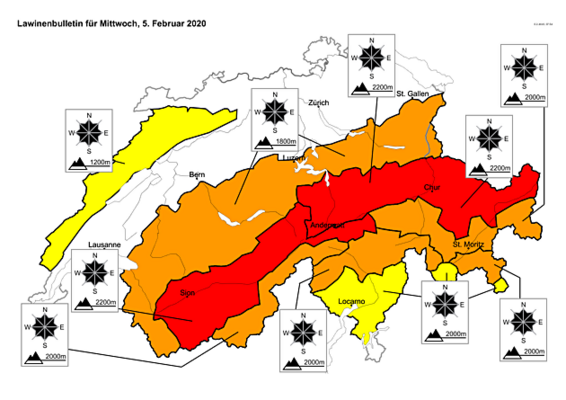Yes. Snow-covered forests, white peaks and pristine, glistening slopes tempt many people into the great outdoors, away from the hustle and bustle of everyday life. Snowshoeing is the perfect way to soak up the scenery, but, as with other winter activities, the danger of avalanches is all too real. To help prevent avalanche accidents, you should find out about the avalanche danger, check the weather forecast, plan your trip carefully, and ensure you have the right equipment and training.
On average, one to two snowshoers are killed in avalanches each year in the Swiss Alps, and the numbers are rising. Avalanche accidents occur in open terrain, away from secure pistes and trails. Slab avalanches are a particular hazard for winter sports enthusiasts, and over 90% of those killed by avalanches trigger the avalanche themselves. Even in terrain where they feel relatively safe, such as the Alpine foothills, the Jura and lightly forested areas, snowshoe hikers can still set off an avalanche. Moreover, summer trails can be at risk from avalanches in winter.
Preventive behaviour is required to reduce the avalanche risk when snowshoeing to an acceptable level. The SLF therefore recommends that snowshoers always ascertain the current avalanche danger, check the weather forecast, carry the right kit (including the standard emergency equipment of avalanche transceiver, shovel and probe), study the terrain for warning signs of avalanches and adapt their behaviour to the conditions. In open terrain, experience in assessing the avalanche danger is essential. You should therefore attend an avalanche course if you are planning to go snowshoeing on your own initiative. This will ensure that your hike is as safe as possible and one that you remember for all the right reasons.
Avalanches: do's and don'ts when snowshoeing
- Inexperienced hikers are advised to stick to open snowshoe routes.
- Never go snowshoeing alone.
- Attend an avalanche course.
- Check the avalanche bulletin and snow situation before each trip.
- Carry emergency equipment with you, i.e. an avalanche transceiver, probe and shovel.
Information sources
Avalanche Bulletin: The content of the avalanche bulletin is designed as an informed warning. It is published twice daily in winter and primarily contains a forecast of the avalanche danger.
White Risk app: White Risk is the app for all those who engage in winter activities in the mountains outside marked and open pistes. By way of the avalanche bulletin and snow and weather data, it gives users up-to-date information about the snow and avalanche situation in Switzerland.
White Risk portal: White Risk is a web-based, interactive avalanche prevention platform.
Contact
Links
- Avalanche science and prevention
- bfu: Tips on behaviour and equipment (in german)
- Swiss Alpine Club (SAC) guide: Safety when snowshoeing
- Avalanche courses: Swiss Alpine Club SAC
Copyright
WSL and SLF provide the artwork for imaging of press articles relating to this media release for free. Transferring and saving the images in image databases and saving of images by third parties is not allowed.

